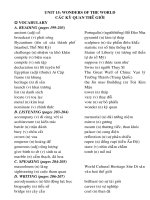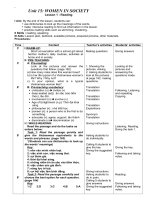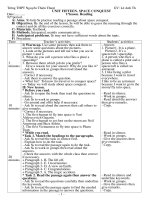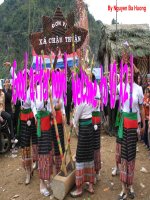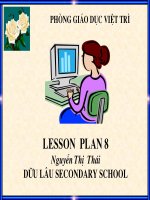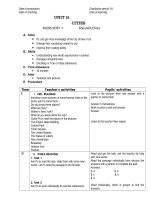unit 15
Bạn đang xem bản rút gọn của tài liệu. Xem và tải ngay bản đầy đủ của tài liệu tại đây (70.14 KB, 11 trang )
Trêng THPT NguyÔn ThiÖn ThuËt GV: Lª Anh Th
UNIT FIFTEEN. SPACE CONQUEST
Date: ……… 1
st
lesson. Reading
92
nd
period.
A) Aims. To help Ss practise reading a passage about space conquest.
B) Objectives. By the end of the lesson, Ss will be able to guess the meaning through the
context and do all the exercises correctly.
C) Materials. Textbook.
D) Methods. Integrated, mainly communicative.
E) Anticipated problems. Ss may not have sufficient words about the topic.
F) Procedure.
Time Teacher’s activities Students’ activities
3
minutes
10
minutes
I) Warm up. Use some pictures then ask them to
answer some questions about the pictures.
1. Look at the pictures and tell me what you see in
picture 1 and 2.
2. What do you call a person who flies a plan/ a
spaceship?
3. Between them which job do you prefer?
Give a reason for your answer. Why do you like it?
- Ask Ss to work in groups then read aloud the answers.
- Correct if necessary.
- Ask them to answer the question.
+ What for? To know /to travel or to conquer space?
=> Today we will study about space conquest.
II) New lesson.
* Before you read.
- Ask Ss to open the book then read the questions in
silence.
- Ask Ss to work in groups.
- Go around and offer help if necessary.
- Ask Ss to read aloud the answers then call others to
give remarks.
- Correct if necessary.
1. The first human to fly into space is Yuri
Alekseyevich Gagarin.
2. The first human to set foot on the moon are Neil
Amstrong and Buzz Aldrin.
3. The first Vietnamese to fly into space is Pham Tuan.
* While you read.
*Task 1. Match the headings to the paragraphs.
- Ask Ss to read the task in silence first.
- Explain how to do the task.
- Ask Ss to read the passage again to do the task.
- Ask Ss to work in groups then read aloud the answers.
- Check the answers with the whole class then correct
if necessary.
+ Paragraph 1- B. The lift off.
+ Paragraph 2- E. Uncertainties.
- Answer.
1. Picture1. It is a plane.
Picture2. It’s a spacecraft
/ spaceship.
2. A person who flies a
plane is called a pilot and a
person who flies a
spacecraft is called an
astronaut.
3. I like being a pilot
because I want to travel
everywhere.
I like to be an astronaut
because I want to go to the
moon/ fly into space.
- Read in silence.
- Work in groups.
- Read aloud the answers
then give remarks.
- Copy.
- Read in silence.
- Work in groups.
- Give the answers then
give remarks.
- Copy.
- 1 -
Trêng THPT NguyÔn ThiÖn ThuËt GV: Lª Anh Th
20
minutes
10
minutes
2
minutes
+ Paragraph 3- D. A view on Earth.
+ Paragraph 4- C. Congratulations
+ Paragraph 5. A. The tragic accident.
* Task 2. Read the passage again then answer the
questions.
- Ask Ss to read the questions carefully then underline
the keywords.
- Ask Ss to read the passage again to find the needed
information in the passage to answer the questions.
- Ask Ss to work in groups and go around to offer help
if necessary.
-Ask Ss to read aloud the answers then call others to
give remarks.
- Give corrective feedback if necessary.
1. He was 27 then.
2. He was in space for 108 minutes.
3. They were: what would happen to a human being in
space or how the body would react to the extreme
changes in temperature or how the mind would deal
with the psychological tension.
4. It was more than 17,000 miles per hour.
5. Because he died in a plane crash on a routine
training flight in March 1968.
6. After his death, his home town of Gzhatsk was
renamed Gagarin, and the Cosmonaut Training Center
at Star City, Russia, was given the name of this
national hero.
* After you read.
- Ask Ss to read the summary of the reading passage
then work in groups.
- Go around and offer help if necessary.
- Ask Ss to read aloud the answers then call others to
give remarks.
- Give corrective feedback if necessary.
1. cosmonaut 2. in space
3. lasted 4. success
5. gravity 6. view
7. impossible 8. named after.
III) Homework assignment.
Ask Ss to translate the passage into Vietnamese and
prepare “ Speaking” in advance.
- Read in silence and
underline keywords.
- Work in groups.
- Give the answers then
give remarks.
- Copy.
- Work in groups then read
aloud the answers.
- Give remarks then copy.
- 2 -
Trêng THPT NguyÔn ThiÖn ThuËt GV: Lª Anh Th
UNIT FIFTEEN. SPACE CONQUEST
Date: .. …… 2
nd
lesson. Speaking
93
rd
period.
A) Aims. To help Ss practise speaking about the first flight into space of China and talk about
the events of space conquest.
B) Objectives. By the end of the lesson, Ss will be able to talk about the events of space
conquest.
C) Materials. Textbook.
D) Methods. Integrated, mainly communicative.
E) Anticipated problems. Ss may not have sufficient vocabulary to talk about the topic.
F) Procedure.
Time Teacher’s activities Students’ activities.
3
minutes
15
minutes
I) Warm up. Look at the pictures then answer the
questions.
1. Who are they?
2. What are their nationalities?
- Ask Ss to worhk in groups.
- Ask Ss to read aloud the answers then correct if
necessary.
II) New lesson.
* Task 1. Read the following piece of news, then make
questions and answers.
- Ask Ss to read the passage in silence then find out
newwords.
- Help Ss deal with the newwords then explain how to do
the task.
- Give Ss some guiding words.
+ When .?………………………
+ What ..?………………………
+ How old ?……………………
+ How important .?……………
+ How many ..?…………………
- Ask Ss to work in groups then read aloud the answers.
- Ask others to give remarks.
- Correct their mistakes if necessary.
A. When did China launch its first maned spacecraft into
space?
B. On October 15, 2003.
A. What is the name of China’s first maned spacecraft?
B. Its name is Shenzhou 5.
A. What is the name of the astronaut?
B. His name is Yang Liwei.
A. How old was he when he flew into space?
B. He was 38 years old.
A. How important was the successful flight to China?
B. The successful flight maked a milestone in China’s
space project.
A. How many countries in the world have been able to
- Answer.
P1. He’s Pham Tuan-
Vietnamese astronaut.
P2. He is Yuri Gagarin-
Russian cosmonaut.
P3. He’s Liwei- Chinese
astronaut.
- Read in silence.
- Make questions and
answers.
- Give remarks.
- Copy.
- 3 -
Trêng THPT NguyÔn ThiÖn ThuËt GV: Lª Anh Th
25
minutes
2
minutes
carry out independently maned space activities? What are
they?
B. There have been three. They are : Russia, The United
State and China.
* Task 2. Take turns to talk about the important events
in space exploration.
- Ask Ss to read task 2 carefully then find out newwords.
- Help Ss deal with the newwords and explain how to do
the task.
- Make models with good students.
* Setting model.
+ Picture 1
A. When did Russia launch its first artificial sattelite?
B. On October 4, 1957.
A. What is the name of Russia’s first artificial sattelite?
B. Sputnik.
A. How important was the first artificial sattelite To
Russia?
B. The first artificial sattelite marked the beginning of
Space Age.
+ Picture 4.
A. Who is the first woman to fly into space?
B. That is Valentina Tereshkova, a Russian cosmonaut.
A. When did she fly into space?
B. On June 16, 1963.
+ Picture 5.
A. Who are the first humans to set foot on the moon?
B. They are Neil Amstrong and Buzz Aldrin American
astronauta.
A. When did they set foot on the moon?
B. On July 20,1969.
+ Picture 6.
A. Who is the first Vietnamese to fly into space?
B. That is Pham Tuan.
A. With whom did he go along into space?
B. He went with V.V Gorbotko a Russian cosmonaut.
A. How long did he stay in the orbit?
B. He stayed 8 days in the orbit.
- Ask Ss to work in groups.
- Go around and offer help if necessary.
- Ask Ss to work in pairs then read aloud the dialogues.
- Ask others to give remarks.
- Give corrective feedback if necessary.
III) Homework assignments.
Ask Ss to prepare “ Listening” in advance.
- Read in silence.
- Listen to the teacher
then work in groups.
- Read aloud then copy.
- 4 -
Trêng THPT NguyÔn ThiÖn ThuËt GV: Lª Anh Th
UNIT FIFTEEN. SPACE CONQUEST
Date: . ……… 3
rd
lesson. Listening
94
th
period.
A) Aims. To help Ss practise listening about the first human moon landing.
B) Objectives. By the end of the lesson, Ss will be able to develop their listening skill and do
all the tasks correctly.
C) Materials. Textbook.
D) Methods. Integrated, mainly communicative.
E) Anticipated problems. Ss may not be familiar with the listening tasks.
F) Procedure.
Time Teacher’s activities Students’ activities
3
minutes
10
minutes
I) Warm up. Answer the questions.
1. Can you name the first men to set foot on the moon?
2. What are their nationalities?
3. When did they set foot on the moon?
- Ask Ss to work in pairs.
- Check the answers with the whole class.
II) New lesson.
* Before you listen.
+ Match the pictures with the captions.
- Ask Ss to work in groups.
- Ask Ss to read aloud their answers.
- Ask others to give remarks.
- Give corrective answers.
+ Picture a - 2. The Apollo crew.
+ Picture b – 5. The first foot print on the moon.
+ Picture c – 3. Walking on the moon.
+ Picture d – 1. Orbiting.
+ Picture e – 4. The Moon landing.
* Listen and repeat.
- Ask Ss to look at the words in the textbook then read
after the teacher.
- Ask Ss to read aloud then give their meaning.
- Call some Ss to read aloud the words then call others to
give remarks.
- Correct their mispronunciation if necessary.
- Ask Ss to guess what they will hear about.
=> Can you guess what the listening passage is about?
The first human moon landing.
* While you listen.
* Task 1. Listen and decide whether the following
statements are true or false.
- Ask Ss to read the statements carefully and find out
newwords if necessary.
- Explain the newwords and how to do if necessary.
- Ask Ss to read again and underline the keywords.
- Ask Ss to listen to the tapescipt the first time, ask them to
pay attention to the keywords.
- Answer.
1. They are Neil
Amstrong and Buzz
Aldrin.
2. They are American.
3. On July 20, 1969
- Work in groups.
- Read aloud the
answers.
- Give remarks and
copy.
- Listen
- Read aloud
- Copy.
- Read in silence.
- Work in groups.
- Listen to the
- 5 -
